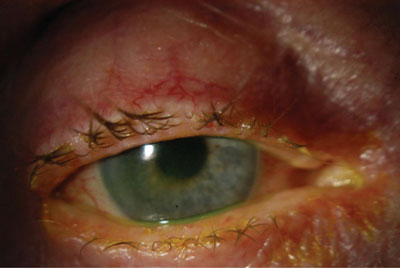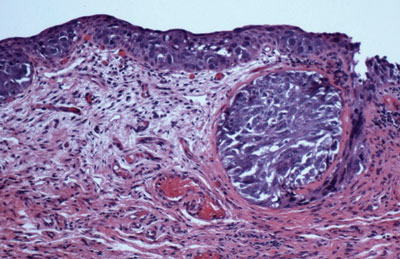Woman presents with unilateral blurry vision, red eye
On examination, eyelid margin thickening and corneal haze were noted.
 Priti Batta |
 Namrata Nandakumar |
An 84-year-old woman was referred to our cornea clinic for blurry vision and redness of the right eye for the past year.
Her ocular history was significant for severe dry eye syndrome and blepharitis, as well as cataract surgery in the right eye. She also had a history of steroid-induced glaucoma due to topical steroids used to treat her dry eye syndrome. The patient had been on several topical medications over the past year, including Restasis (cyclosporine ophthalmic emulsion 0.05%, Allergan), Xibrom (bromfenac ophthalmic solution 0.09%, Ista Pharmaceuticals), Pred Forte (prednisolone acetate ophthalmic suspension 1%, Allergan), Tobradex (tobramycin and dexamethasone ophthalmic suspension, Alcon) and Alphagan P (brimonidine tartrate ophthalmic solution, Allergan). Her medical history was notable for polycythemia vera and spinal stenosis.
Examination
On examination, the patient’s best corrected visual acuity was 20/80 in the right eye and 20/30 in the left eye. Her pupils were reactive with no afferent pupillary defect noted. IOPs were in the mid-teens bilaterally. Her external examination was notable for mild right upper eyelid ptosis, as well as right upper and lower eyelid madarosis with thick erythematous lid margins and crusting (Figures 1 and 2). Slit lamp evaluation revealed significant conjunctival papillary response on the right as well as moderate injection. She had diffuse superficial punctate keratopathy, worse in the right eye, and right central corneal haze (Figure 2). Her posterior chamber IOL was well-centered in the right eye with a clear posterior capsule, and she had mild nuclear sclerosis in the left eye. Dilated funduscopic examination was unremarkable in both eyes.
 Figure 1. External photographs revealing mild right upper eyelid ptosis and prominent right eyelid crusting. Images: Liang MC, and Wu HK
|
 Figure 2. External photograph of the right eye showing eyelid margin thickening, telangiectasias, madarosis and central corneal haze. |

What is your diagnosis?
Eyelid margin thickening, madarosis
The differential diagnosis for this patient includes both inflammatory and neoplastic processes. Chronic inflammatory conditions that may cause this presentation include asymmetric severe blepharitis and rosacea, superior limbic keratitis and ocular cicatricial pemphigoid. Neoplastic processes that should be considered include sebaceous cell carcinoma, squamous cell carcinoma and Merkel cell carcinoma.
Differential diagnosis
Blepharitis is a chronic inflammation of the eyelids, presenting with redness, flaking, crusting and foreign body sensation, often accompanied by a transient decrease in vision. It can sometimes be associated with madarosis.
Rosacea is more common in women in their 30s to 60s. Patients present with facial erythema, papules and pustules, and sometimes ocular symptoms including dryness, redness and irritated lids.
Superior limbic keratitis, which this patient was diagnosed with, is inflammation of the superior bulbar conjunctiva with predominant involvement of the superior limbus, adjacent epithelial keratitis and papillary hypertrophy of the upper tarsal conjunctiva; corneal filaments are often seen. It is usually bilateral and presents in middle-aged women. It is thought to be due to superior bulbar conjunctival laxity and is associated with thyroid eye disease, tight upper lids and prominent globes. Surgical resection of the involved conjunctiva, as performed in this case, is one treatment option.
Ocular cicatricial pemphigoid is a systemic autoimmune disease of T-lymphocyte dysregulation that causes a chronic cicatrizing conjunctivitis in patients most often 50 to 60 years old. It can present with meibomian gland dysfunction, trichiasis, symblepharon formation, and corneal defects and scarring.
Basal cell carcinoma is the most common eyelid tumor, most often presenting in the lower lid, then the medial canthus, upper eyelid and lateral canthus. It presents in fair-skinned individuals in areas exposed to UV light or radiation. The typical presentation is a pearly, waxy nodule with telangiectasias and central ulceration, but it can also present in superficial sclerosing or morpheaform patterns. It can invade locally but has no metastatic potential.
Squamous cell carcinoma accounts for 4% to 5% of eyelid malignancies and has a scaly and ulcerating appearance on exam with similar risk factors as basal cell carcinoma. In contrast, however, it can invade locally into the orbit and also spread to lymph nodes and distant sites.
Merkel cell carcinoma is an aggressive primary neuroendocrine cancer of the skin. It presents most often in Caucasian men who are 60 to 80 years old, and its incidence increases with age. It is a firm, painless nodule that is often flesh-colored, red or blue, with a 50% 5-year survival rate after lymph node metastases has occurred.
Diagnosis and management
Because of the progressive nature of this patient’s symptoms and the lack of improvement with steroids, a neoplastic condition was strongly suspected. The patient therefore underwent conjunctival biopsy. Pathological evaluation revealed large neoplastic cells and vacuolated, basophilic cytoplasm, consistent with sebaceous cell carcinoma (Figure 3).
 Figure 3. H&E stain of conjunctival biopsy showing conjunctival epithelium with large cells and vesicular foamy, basophilic cytoplasm. |
As sebaceous cell carcinoma is known for its multicentric spread, a map biopsy of the conjunctiva was then performed, with 11 out of 12 specimens positive for sebaceous cell carcinoma. To rule out local and metastatic spread, the patient had an MRI of the head and neck and a PET scan, which showed no other foci of disease.
Based on the biopsy, which revealed pagetoid spread with no deeper invasion, the patient was offered a trial of topical chemotherapy. She recently began treatment with topical 0.04% mitomycin C four times a day. She remains on topical chemotherapy with plans for surgical treatment if there is no response.
Discussion
Sebaceous cell carcinoma is a highly malignant neoplasm that arises most often from the meibomian glands of the tarsus. Although rare, accounting for only 1% to 5.5% of lid cancers, it is one of the top three most common eyelid malignancies, with basal cell carcinoma being responsible for almost 90%. It is more common in women and usually presents in the sixth to seventh decade of life. Two-thirds of cases occur in the upper eyelid. While the etiology is unknown, sebaceous cell carcinoma has been associated with prior radiation and diuretic use. Muir-Torre syndrome is a rare clinical entity in which sebaceous gland tumors and keratoacanthomas are associated with the development of distant primary malignancies, most commonly colon cancer and genitourinary cancers.
Sebaceous cell carcinoma can present in a variety of ways. It commonly presents as a firm, yellow nodular eyelid lesion and is often mistaken for a chalazion. It can also present as a plaque-like thickening of the tarsal plate with destruction of the meibomian gland orifices and madarosis. As it often mimics chronic conditions such as blepharoconjunctivitis, the average time to diagnosis is 1 to 3 years. Sebaceous cell carcinoma can also spread to the other eyelid, conjunctiva, corneal epithelium, canaliculus and nasal cavity. In 44% to 80% of cases, pagetoid spread involving the conjunctival epithelium occurs. Diagnosis of sebaceous cell carcinoma usually entails a full-thickness wedge biopsy of the affected lid and a map biopsy of the conjunctiva. Pathological evaluation typically reveals large neoplastic cells with vacuolated (“foamy”), basophilic cytoplasm and destruction of the tarsal and adnexal tissues. If sebaceous cell carcinoma is suspected at the time of biopsy, specialized lipid stains such as Oil Red O should be applied before specimen processing, which washes the lipid away. Sebaceous cell carcinoma is most often misdiagnosed as squamous cell carcinoma, but sebaceous cell carcinoma tends to be more basophilic without a lobular arrangement.
Sebaceous cell carcinoma is typically aggressive with a high recurrence rate. It can invade locally into the globe, orbit, sinuses and brain, and it can metastasize to local lymph nodes. Rarely, hematogenous spread occurs to the liver, lungs and bone. Poor prognostic indicators include any type of invasion, diffuse involvement of the upper and lower eyelid, pagetoid spread, tumor size greater than 10 mm and presence of symptoms for longer than 6 months. Mortality rate based on these indicators varies from 0% to 15% for localized lesions to 20% to 40% for pagetoid spread, with much higher mortality rates in the presence of more invasive or metastatic disease.
Treatment options include wide surgical excision or exenteration; cryotherapy can sometimes be used as an adjunct to local excision. Radiation can also be beneficial; however, radiation may be inadequate when used alone, due to both tumor resistance and recurrence. Topical chemotherapy with MMC is a relatively new modality of treatment. Topical MMC has shown to be successful in treating conjunctival squamous cell carcinoma, and recent data has shown positive results with certain types of sebaceous cell carcinoma as well. A typical treatment regimen involves three to four 1-week cycles of topical MMC, four times daily, with 1-week breaks in between cycles.
Common side effects include allergic reactions and punctal stenosis, as well as conjunctival and corneal surface irritation. Rarely, it may cause wound breakdown, cataract, glaucoma, corneal and scleral necrosis, and limbal stem cell deficiency.
References:
- Chao AN, Shields CL, Krema H, Shields JA. Outcome of patients with periocular sebaceous gland carcinoma with and without conjunctival intraepithelial invasion. Ophthalmology. 2001;108(10):1877-1883.
- Johnson S, Nerad JA, Syed NA. Sebaceous cell carcinoma: a masquerade syndrome. EyeRounds.org. http://webeye.ophth.uiowa.edu/eyeforum/cases/62-Sebaceous-Cell-Carcinoma-Eyelid-Masquerade-Syndrome.htm. Jan. 23, 2006.
- Khong JJ, Muecke J. Complications of mitomycin C therapy in 100 eyes with ocular surface neoplasia. Br J Ophthalmol. 2006;90(7):819-822.
- Shields CL, Naseripour M, Shields JA, Eagle RC Jr. Topical mitomycin-C for pagetoid invasion of the conjunctiva by eyelid sebaceous gland carcinoma. Ophthalmology. 2002;109(11):2129-2133.
- Shields JA, Demirci H, Marr BP, Eagle RC Jr, Shields CL. Sebaceous carcinoma of the eyelids: personal experience with 60 cases. Ophthalmology. 2004:111(12):2151-2157.
- Yanoff M, Duker JS. Ophthalmology. 3rd ed. Philadelphia: Elsevier; 2009.
- Michelle C. Liang, MD, and Helen K. Wu, MD, can be reached at New England Eye Center, Tufts University School of Medicine, 750 Washington St., Box 450, Boston, MA 02111; 617-636-4219; fax: 617-636-4866; website: www.neec.com.
- Edited by Priti Batta, MD, and Namrata Nandakumar, MD. Drs. Batta and Nandakumar can be reached at New England Eye Center, Tufts University School of Medicine, 750 Washington St., Box 450, Boston, MA 02111; 617-636-4219; fax: 617-636-4866; website: www.neec.com.

